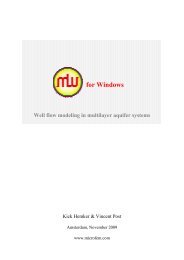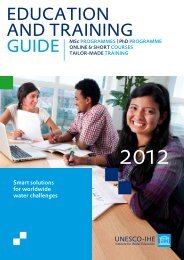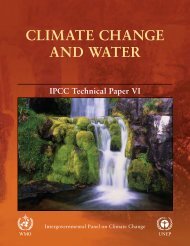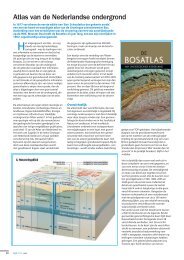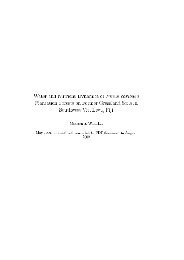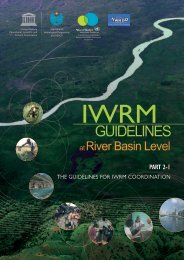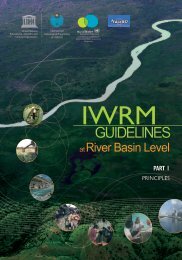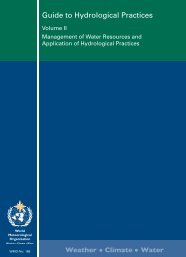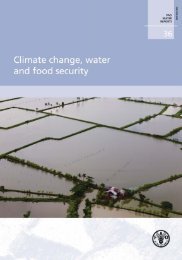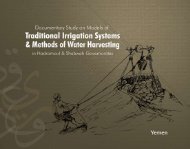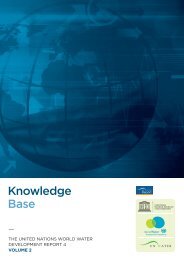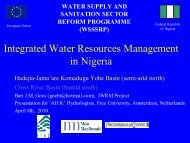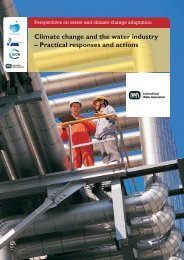Guide to Hydrological Practices, 6th edition, Volume I - Hydrology.nl
Guide to Hydrological Practices, 6th edition, Volume I - Hydrology.nl
Guide to Hydrological Practices, 6th edition, Volume I - Hydrology.nl
You also want an ePaper? Increase the reach of your titles
YUMPU automatically turns print PDFs into web optimized ePapers that Google loves.
CHAPTER 1<br />
INTRODUCTION<br />
1.1 BACKGROUND<br />
<strong>Hydrology</strong> is the science that deals with the occurrence<br />
and distribution of the waters of the Earth in<br />
time and space, both above and below the land<br />
surface, including their chemical, biological and<br />
physical properties, and their interaction with the<br />
physical environment (WMO/UNESCO, 1992). It<br />
provides an understanding of various phases of<br />
water as it passes from the atmosphere <strong>to</strong> the Earth<br />
and returns <strong>to</strong> the atmosphere. As such, it forms the<br />
basis for water resources assessment and management<br />
and the solution of practical problems relating<br />
<strong>to</strong> floods and droughts, erosion and sediment transport<br />
and water pollution. Increasing stress on the<br />
available water resources in the search for improved<br />
economic well-being and concerns for the pollution<br />
of surface water and groundwater have<br />
highlighted the central role of hydrology in all<br />
water and environment initiatives.<br />
To provide guidance in moni<strong>to</strong>ring this vital<br />
resource, which is central <strong>to</strong> the development<br />
and well-being of humankind, the World<br />
Meteorological Organization (WMO) Commission<br />
for <strong>Hydrology</strong>, at its first session (Washing<strong>to</strong>n<br />
DC, 1961), recognized the urgent need for the<br />
preparation of a guide <strong>to</strong> the relevant operational<br />
practices. As a result, the first <strong>edition</strong> was<br />
published in 1965 as the <strong>Guide</strong> <strong>to</strong> Hydrometeorological<br />
<strong>Practices</strong>.<br />
The second and third <strong>edition</strong>s of the <strong>Guide</strong> were<br />
published in 1970 and 1974, respectively. The third<br />
<strong>edition</strong> was entitled <strong>Guide</strong> <strong>to</strong> <strong>Hydrological</strong> <strong>Practices</strong> in<br />
recognition of the broader scope of its contents.<br />
Subsequently, during its fifth session (Ottawa,<br />
1976), the Commission approved the revision of<br />
and substantial additions <strong>to</strong> the <strong>Guide</strong> <strong>to</strong> produce a<br />
fourth <strong>edition</strong>, which was issued in two volumes.<br />
<strong>Volume</strong> I dealt with data acquisition and processing<br />
and <strong>Volume</strong> II with analysis, forecasting and other<br />
applications. <strong>Volume</strong>s I and II of the fourth <strong>edition</strong><br />
were published in 1981 and 1983, respectively.<br />
With the evolution of technology, and the evolution<br />
of the <strong>Hydrology</strong> and Water Resources activities<br />
within WMO, the fifth <strong>edition</strong> of the <strong>Guide</strong> was<br />
published in 1994 as one consolidated volume. It<br />
was also published on a CD-ROM for easy outreach<br />
<strong>to</strong> a wider water management community, beyond<br />
the traditional WMO constituency.<br />
In 1999, the World Meteorological Congress<br />
adopted “Weather, Climate and Water” as the official<br />
subtitle of the Organization and the Commission<br />
for <strong>Hydrology</strong>, at its eleventh session in Abuja,<br />
Nigeria, in 2000, recommended that the sixth<br />
<strong>edition</strong> of the <strong>Guide</strong> be published as a live document<br />
<strong>to</strong> be uploaded <strong>to</strong> the Internet and updated<br />
more frequently, as and when required.<br />
1.2 SCOPE<br />
The accepted principles of integrated water resources<br />
management dictate that, in order <strong>to</strong> achieve<br />
environmental sustainability and economic<br />
productivity, rivers must be managed at the basin<br />
level. Today, when water is perceived <strong>to</strong> be<br />
everybody’s business, various stakeholders, at the<br />
national as well as at international level, participate<br />
and play important roles in the process. Many<br />
institutions and agencies within a country are<br />
engaged in the collection of hydrological data and<br />
information. These data may be collected by various<br />
agencies using different measurement procedures.<br />
The resulting lack of homogeneity in the<br />
observations gives rise <strong>to</strong> a lack of confidence. It is<br />
imperative, therefore, that all these partners be<br />
made aware of the manner in which the hydrological<br />
data are collected, the limitations and the reliability<br />
of the data, and how they are <strong>to</strong> be managed by the<br />
responsible organizations in the basin. Transparency<br />
in data collection, s<strong>to</strong>rage and sharing is an essential<br />
element for cooperation among various users. A<br />
quality management framework for hydrometry<br />
and hydrological information is fundamental in<br />
using hydrological information from diverse<br />
sources.<br />
The growing demand for freshwater resources has<br />
increasingly focused the attention of governments<br />
and civil society on the importance of cooperative<br />
management. Sharing the benefits of cooperation<br />
and even conflict prevention stem from a broad<br />
understanding of the principles and mechanisms<br />
through which these results can be achieved.<br />
Transboundary rivers have the potential <strong>to</strong> bring<br />
countries <strong>to</strong>gether both economically and politically<br />
or, conversely, they can cause economic and<br />
political tensions. The risk fac<strong>to</strong>r in decisionmaking<br />
in water resources management is a



